SEO
How to Create an Affiliate Marketing Website That Converts

Would you love to replace your regular “9 to 5” and eventually generate passive income even when you sleep? A successful affiliate marketing website can do just that, and even beginners can earn additional income from the comfort of their own homes.
The concept of affiliate marketing involves advertising and promoting other people’s products or services and receiving a commission for each sale. The key is to build a website that can be an authoritative, trusted source and provide helpful content for your audience.
Anyone can build an affiliate marketing website earning at least four figures a month, but it’s not as easy as just throwing up any old site. To succeed, you must build a solid foundation to get off on the right foot.
As someone who has built, managed, bought, and sold affiliate sites over the years, I am going to tell you how to create an affiliate marketing website that actually converts and starts earning you income within a matter of months.
Like a referral service, affiliate marketing involves promoting products or services from another person or company. You can earn money by joining affiliate programs and plugging products on your website, blog, or social platforms suitable for your target audience.
Affiliate marketing is used by e-commerce sites, brands, and private companies in various industries to grow their customer base, traffic, and revenue. From designer handbags to psychic readings, there is an opportunity to promote almost anything.
According to eMarketer, 31% of U.S. brands said that affiliate marketing was the top revenue source in 2021. This should come as no surprise since affiliate marketing is a $12 billion industry.
Whether with a private affiliate program or through an affiliate network like Amazon Associates, once approved, you will be provided individualized links to website placements. You earn a commission when a user clicks a link and purchases an item.

Who can be an affiliate?
The ability to become an affiliate marketer is open to everyone; however, you need specific skills, knowledge, and experience to succeed.
You’ll need to figure out the best niche for your site and what products to promote to get started. Then you’ll need an SEO-optimized, accessible website that offers high-quality content to your audience to be considered as an affiliate partner.
But it’s important to remember this is also a business. You’ll need a solid business plan and business management skills to successfully scale your site long-term.
Running an affiliate marketing website is an increasingly popular way to make money online. It is a desirable business strategy, as it can generate large returns with a small initial investment.
So why do so many people want to get into affiliate marketing? Let’s look at some of the top reasons.
Low acquisition cost
Affiliate marketing is a lucrative business concept for people looking to start a side business or earn an extra income due to its low initial cost.
If you have the skills and knowledge to create an affiliate marketing website yourself and write the initial content it needs to get off the ground, it will cost nothing more than your time and initial setup fees for hosting and a domain.
Even if you choose to buy an established site to speed up success, the likelihood is your ROI will quickly exceed the cost of acquiring the site.
No shipping or inventory required
Unlike e-commerce models, you don’t have to worry about inventory or shipping as an affiliate marketer. Because the sponsoring retailer or business handles these tasks. As a result, you can focus solely on promoting the goods and services of your affiliate partner.
You can earn income reasonably quickly
Although you may not earn six figures straight off the mark (which is definitely achievable over time), you can earn a decent income or at least enough to cover the costs of running your site within a matter of months.
In January 2023, I started an affiliate website on an aged domain that is now (just) generating four figures in affiliate commissions per month. Although the site is only just getting off the ground, commissions are steadily increasing (along with traffic).
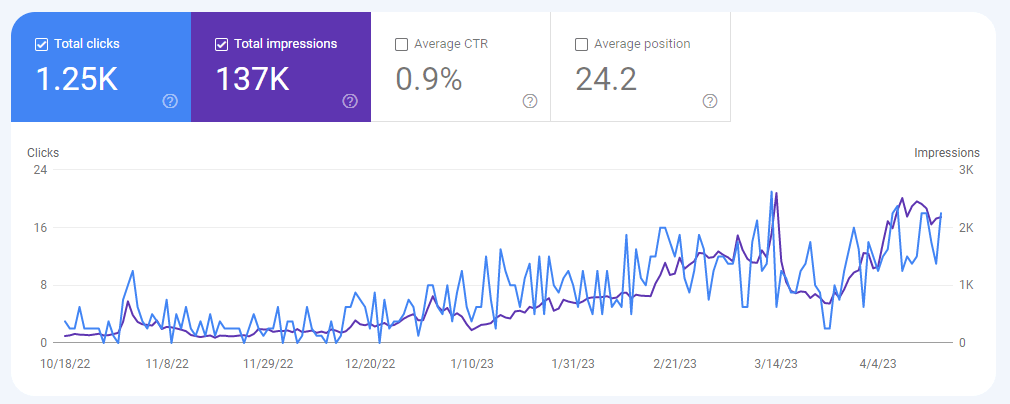
Granted, this site has a high-paying private affiliate at $80–$150 commission per sale (higher than most affiliate programs) in a specific but popular niche (low traffic with high conversion rates). But it shows it can be done.
Just for comparison, I also started another affiliate site around the same time in a different niche, which is solely monetized through Amazon Associates. This is also now earning affiliate commissions but at a significantly lower amount. Still, it’s earning.

Flipping niche sites is also a highly profitable business model that many friends in the SEO community have their hand in. The idea is (much like flipping a house) to either build a site from scratch and sell it or buy an existing site, do some work on it, and sell it for a profit.
Affiliate sites sell now for anywhere between 30X to 40X their monthly income. That means if you can build a quality site that earns $1,000 a month within a few months, you can sell that site for anywhere between $32,000 and $40,000.
You can sell your site (or pick up a new one) from a reputable website marketplace like Flippa, Investors Club, or Empire Flippers.
These sites will assess your site and do full checks on the quality of your content and backlinks. This is to ensure you get an accurate estimate for your site and that a potential buyer doesn’t buy something that may be hit by a Google penalty.
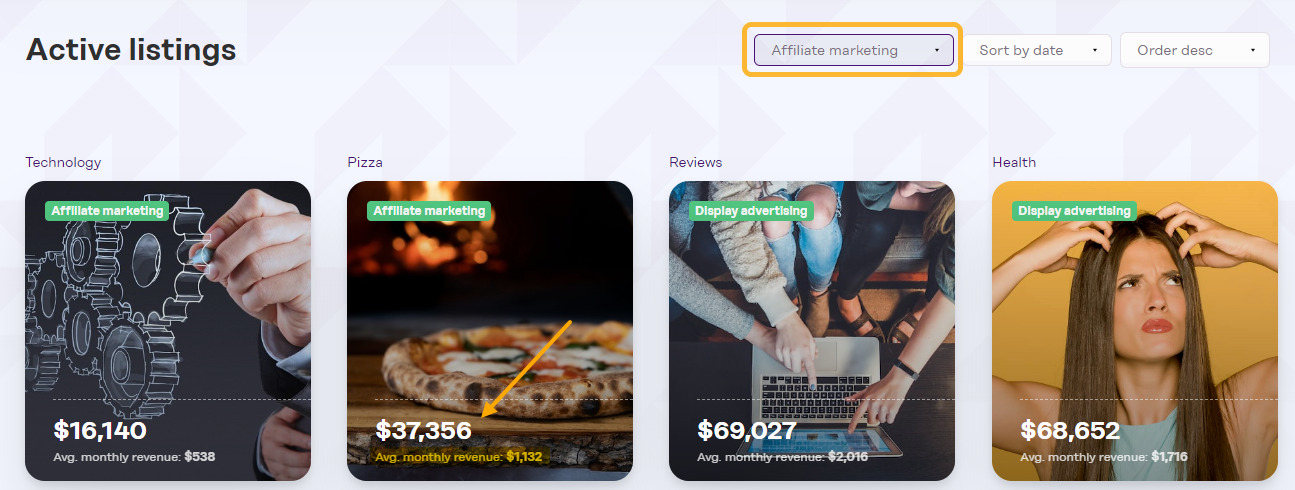
The bottom line is affiliate marketing allows you to make money without the hassle and expenses associated with traditional business models.
Now that we’ve covered what affiliate marketing is and who can become an affiliate marketer, I’m sure you’re chomping at the bit to find out how you can get started.
Let’s look at everything you need to do to create an affiliate website that has a solid foundation and is set up for success.
1. Identify your niche
To start an affiliate marketing website, you must identify your niche and target audience. The following steps will help you choose a niche.
Consider your expertise and interests
More experienced affiliate marketers will usually choose a niche solely on commission rates and products available. But when creating your first affiliate site, you may want to choose something closer to home.
Choosing a niche that you are knowledgeable about makes it easier to create relevant content yourself and stay interested.
Let’s say you love fishing and are well versed in everything related to the topic. You are relatively knowledgeable about the different types of fishing rods, fishing gear, required permits, and licenses. Fishing becomes a great niche that you can focus on.

The key is choosing a niche you are interested in but not your life’s greatest passion. If you’re too invested, handing the ropes over to writers and editors down the line will be difficult. This is something you will need to do to scale your affiliate site.
Do research to find popular niches
Now you’ve considered which niches you’re interested in, you need to consider other factors like if they are seasonal, are highly competitive, and offer the opportunity to scale in the long term.
A niche that is too broad may drive lots of traffic but will often have much lower conversions. Likewise, for a niche that is too specific, it will be hard to scale up over a number of years, as there simply may not be enough topics to cover.
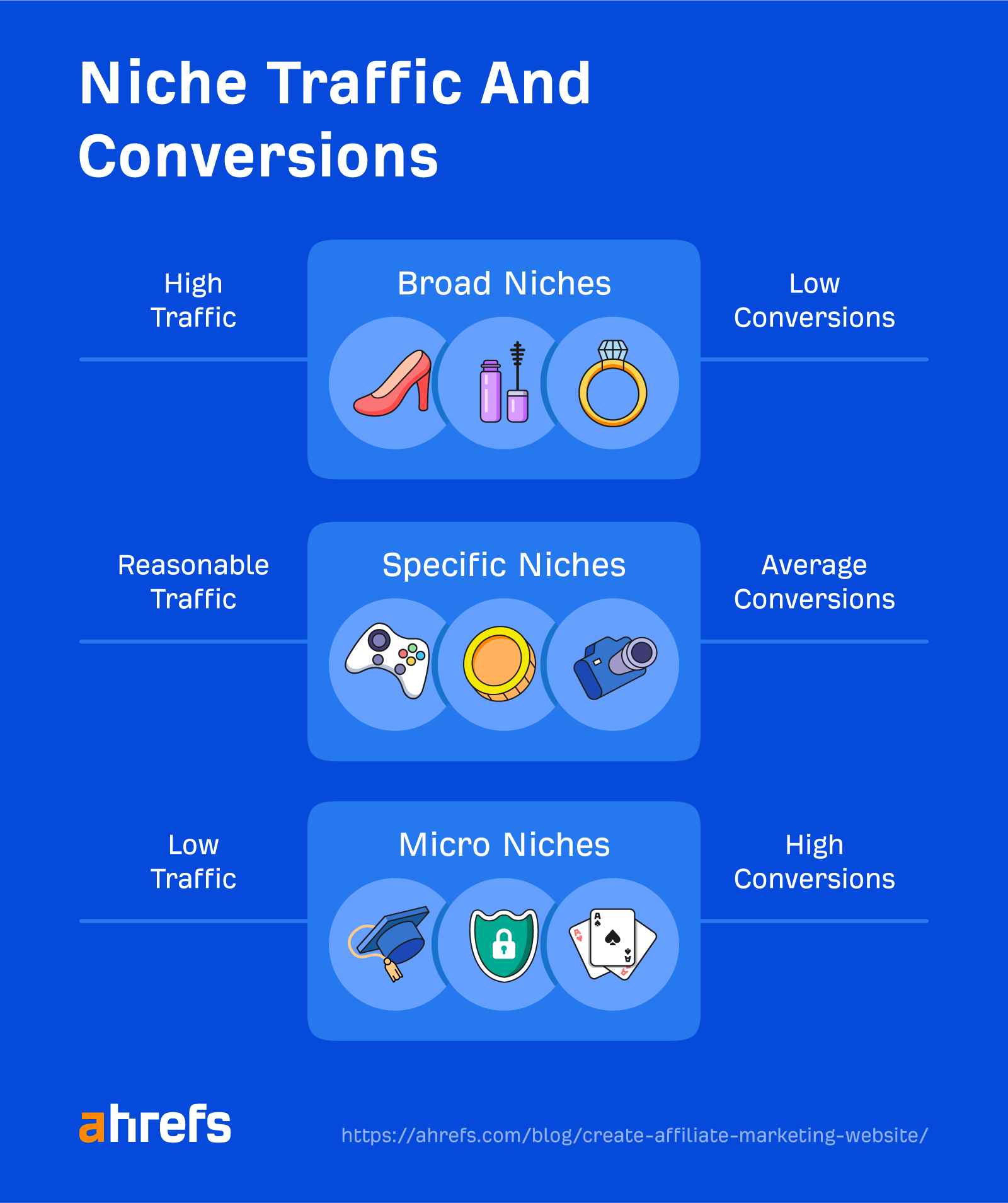
Perform a competitor analysis
Once you have identified a possible niche, you need to understand what sites are already out there and whether you can compete with them. That is where competitor analysis comes in.
By conducting competitor analysis, you can:
- Learn what works and what doesn’t in the chosen niche.
- Find niche competitors’ weaknesses and capitalize on them.
- Find competitors’ strengths and replicate them.
- Understand what SEO tasks to prioritize going forward.
- Understand how difficult outperforming competitors on the SERPs (search engine results pages) is likely to be.
This can give you a solid plan (as well as some inspiration) to get you started.
Consider niche profitability
Choosing a niche with a high profit potential is essential. Remember, it costs you the same to produce content for your site, regardless of the prices of the products you are promoting.
If you’re paying writers and editors to produce your content, you’re going to want to promote products where the commissions can at least cover the cost of production for that article. If your chosen niche only offers products under $10, it’s time to return to the drawing board.
The ideal scenario is to have a niche with multiple affiliate programs on offer, some of which should offer either a high commission percentage with high-ticket items (e.g., 10% commissions with items over $200) or a high set fee per commission (e.g., $100 per sale).
If you are a newbie, you may have to use a beginner affiliate program with lower commissions to start. But knowing you have the option to move to a bigger and better program as your site grows is important.
2. Choose the right affiliate programs
Once you’re set on a niche and know it has high profit potential, it is time to narrow down the affiliate programs you can partner with. You can look into both private affiliate programs and affiliate networks that are open to beginners.
You can find affiliate marketing programs suited to your specialty and market by searching online. Consider factors such as commission rates, payment schedules, and the program’s reputation.
Scouting affiliate networks is one of my favorite ways to find great affiliate programs. Affiliate networks like Commission Junction and ShareASale are a great place to start. Affiliate programs can be found in different categories in these networks.

When you search for a category, it will bring up several merchants with their key information, like commission per sale. Often, you can simply click a button and fill in a quick form to apply.

Using Google is one of the easiest ways to find independent affiliate programs.
Most online businesses offer some form of an affiliate program. Use site:domain.com + affiliate or (product name) + affiliate program to find programs.
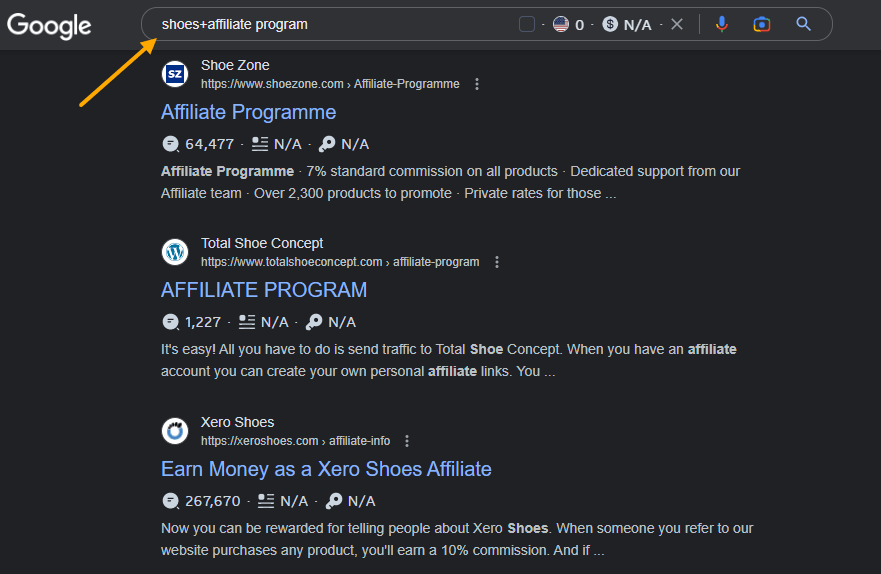
Simply click the link to head to the affiliate page for full information and how to apply.

Affiliate programs can also be found by reading product reviews on a competitor’s site. To find such sites, you can search for what a user is looking for.
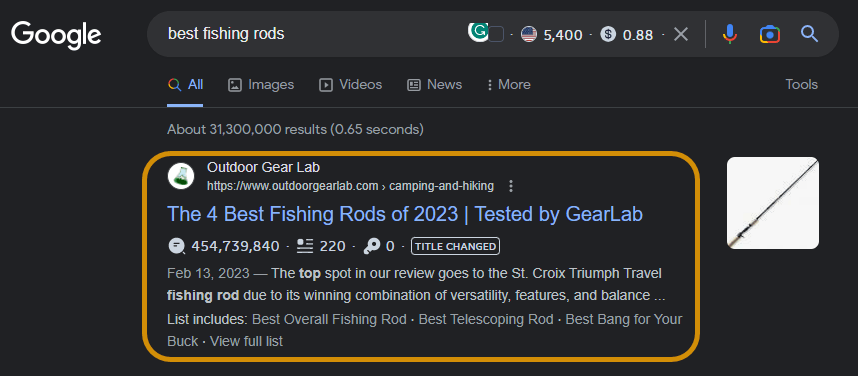

If you are just starting an affiliate marketing website, being able to promote products through a private affiliate may not be an option. Many programs want to know if you will drive traffic their way before approving you as a partner.
Because of this, you may need to (at least initially) join a beginner affiliate program so that once you’ve built up traffic, sales, and commissions, you can show those metrics to a private affiliate as part of your application.
Many affiliate programs suitable for newbies often have lower commission rates but are much more likely to accept you as a partner. Some top choices include:
- Amazon Associates Program – The Amazon Affiliate Program is one of the earliest affiliate programs and is considered one of the best for beginners. Earn 1% to 20% referral fees when affiliates share links that lead to sales.
- Rakuten – The Rakuten network includes affiliate programs for popular retailers such as Macy’s, Lego, and Wayfair. Products that are eligible for compensation through the Rakuten Affiliate Program are determined by each company and its Affiliate Program regulations.
- Impact – The Impact affiliate marketing platform connects customers with major brands such as Adidas, Uber, HSBC, and Airbnb. The company’s automation tools are known for streamlining campaigns and increasing sales.
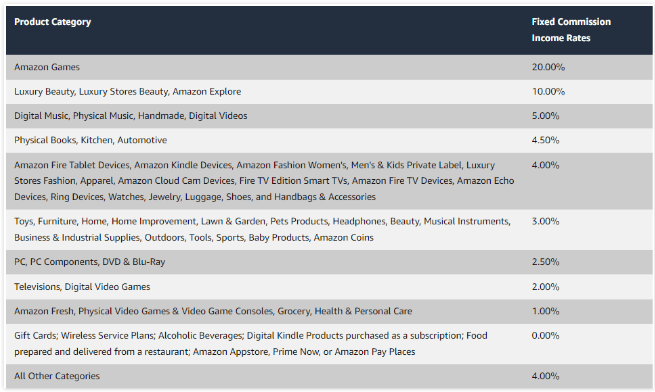
3. Build your affiliate marketing website
An affiliate marketing website requires a content management system (CMS), hosting provider, domain name selection, and plugin installation. If you would like to create a website for affiliate marketing, you should follow these steps:
Domain name selection
What’s in a name? I’m sure Mr. Shakespeare wasn’t talking about affiliate marketing websites, but it is quite an important decision.
Determining the best route for domain name selection will depend on a couple of factors:
- Do you want to build a site from scratch or start with a leg up?
- If you are building a site, are you hoping to flip it later or build a brand over several years?
First, you must choose whether to use a fresh domain, a dropped domain, or an aged domain.
You’re also going to have to consider whether you want an exact match domain (one that has the keywords in the name like fishingrodreviews.com), a partial match domain (something like fishingfriends.com), or a branded domain (something relevant like anglingdreamer.com).
Personally, I recommend using a branded domain because not only is there no evidence of keyword-based domains offering any kind of SEO bonus, but it will also help you with brand building as your business grows.
With a fresh domain (one you pick up from GoDaddy that has never been used before), you have the freedom to create whatever you want. If you’re planning to create a site that you will make your long-term business, this could be the best option.
A fresh domain may mean you start from scratch. But if you have dreams of being the next big name in your niche (like Healthline or Gear Lab), creating the perfect brand from the get-go will be important.
It might not be such a big deal, however, if you are just building a site to flip later.
With aged and dropped domains, you pick up a domain that was previously used and had a site on it. The benefits to this are that they often already have backlinks and some authority behind them, which could help you skip the elusive “Google sandbox.”
However, both of these types of domains come with their risks. If you are thinking of building a site on an aged or dropped domain, you’ll need to do full due diligence. Also, it is recommended to use a reputable marketplace like ODYS.

Choosing a host
There are plenty of reputable hosting companies to choose from. The ideal option is to choose a host that is super fast and offers everything that you need, such as automated backups and a CDN. However, some of these hosts may not be the most budget-friendly for those just starting out.
You may want to start with a beginner option like SiteGround, which is a good option for sites that don’t have a lot of traffic, and then upgrade once your site gets off the ground.
Set up a content management system
Deciding which content management system to use when building any website is crucial. There are many options out there, like Wix, Squarespace, and Shopify. But when it comes to affiliate marketing websites, WordPress is the best option.
Approximately 43% of websites on the internet use WordPress, making it the most popular CMS. As one of the most versatile CMSes, it offers functionality, customization, and versatility, making it ideal for affiliate websites.
Themes and plugins need to be installed
When working with WordPress, you will also need to choose a theme to get started. Choosing a theme that offers a professional and visually impressive user experience is important to gain trust with new users.
There are plenty of free options, but I personally prefer the AffiliateFish theme since it basically provides you with an affiliate site in a box. It is a paid theme, but it has everything you need, e.g., custom product boxes, comparison tables, etc.

As far as plugins are concerned, you’ll want to limit how many you use, as they can slow down your site. Cache plugins, SEO plugins, and backup plugins are essential plugins. These plugins can improve your website’s functionality, safety, and search engine ranking.
However, there are some non-essential plugins that can help you when getting started with an affiliate site.
My top choices include the Ahrefs plugin to audit content and optimize for organic traffic, Link Whisper to automate internal links, and affiliate link cloaking plugins like Pretty Links or ThirstyAffiliates.
4. Design your website
For affiliate marketing, high-quality website design is vital for the following reasons:
- Branding – Designing your website can establish your brand identity and differentiate you from your competition.
- User engagement – Engagement and user experience can be affected by the design of your website. A clean and organized layout can make user navigation easier.
- Trust and credibility – A well-designed website is the first step in building trust and credibility with your audience. A visually appealing and professional website can enhance your audience’s perception of your recommendations and create a positive first impression.
- Conversion rates – Your affiliate marketing strategy’s conversion rates can be affected by the design of your website. Users who click on your affiliate links will be more likely to purchase if you have a clear call to action (CTA) and a user-friendly checkout process.
5. Create content that generates traffic and converts visitors into customers
Creating content is the bread and butter of any affiliate marketing site. It’s what gets your audience enthusiastic about the products you recommend enough that they click through to your partner site and earn you those all-important affiliate commissions.
Researching keywords is the first essential step in creating killer content. The three main types of keywords you need for any affiliate site are:
- General comparisons – Best dog bowl, best tarot cards, etc.
- Branded comparisons – Nike Air Max vs. Adidas Stan Smith.
- Product reviews – Samsung Tab A7 Lite review.
Of course, it’s important to do keyword research for any site. But with affiliate sites, by focusing on keywords with the right search intent, you can drive higher volumes of better-qualified traffic to your site that has a higher conversion rate.
What I mean by this is someone searching for a “Samsung Tab A7 Lite review” or “Samsung Tab A7 Lite vs. S6 Lite” clearly already has their eye on the product. They are simply looking for a deeper understanding of the product features and pros and cons before purchasing.
These types of content have much higher conversion rates because the reader has already decided they are looking to buy something.
You can find these types of keywords pretty easily using Ahrefs’ Keyword Explorer. Simply enter a list of brands or specific products, go to the Matching terms report, and select “Phrase match.” For branded comparisons, you can use the “Include” filter and enter “vs.”

For product review keywords, simply change the “Include” filter to “review.”
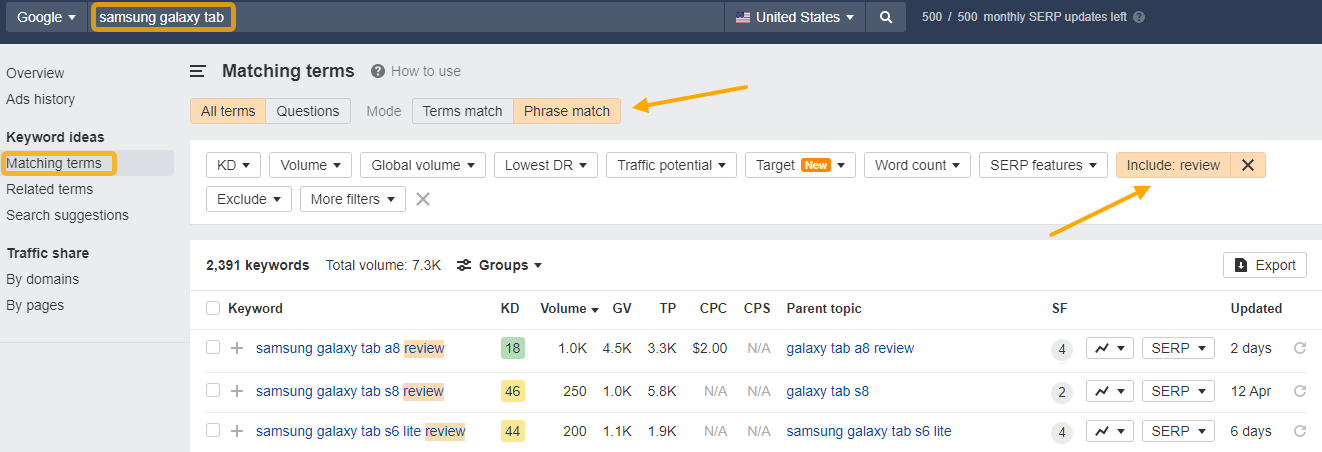
Then, with keywords at the ready, you can start producing highly engaging, evergreen content that your audience wants to read and share.
No matter what niche or what products you’re promoting, there’s one thing every piece of content should have in common: greatness!
Each article should be of top quality, i.e., well written, fun, and engaging. All of your content should be helpful and go the extra mile (where you can!). It should do more than regurgitate Amazon reviews.
This will encourage readers to buy recommended products and build a loyal audience who keeps returning to your site and sharing your content with others.
One of my favorite examples of a quality affiliate site is MyGolfSpy. This article on the “Best Blade Putters” is a great example of high-quality commercial content for a couple of reasons.
First, it starts the article by answering the question in the title and meeting search intent by listing its top putter choices broken down into categories.

Starting an article with a tl;dr (too long, didn’t read), quick product roundup, or “jump to review/recipe/etc.” section allows readers to get the answers they want quickly (meeting search intent) and encourages quick conversions.
Next, the article runs side-by-side comparisons of the top five putter choices for each category (best overall, best from 5 feet, best from 10 feet, etc.) and reviews the different putters’ features.

It also covers an in-depth guide on what you should be looking for in terms of weight, feel, length, and so on. There are also some FAQs and information on how individual putters were tested, showing that reviews are based on actual use and not just paraphrased Amazon reviews.
One of MyGolfSpy’s clever techniques is to use product placements as subtle CTAs. Instead of an overbearing and bold “buy now” or “get it here,” it lists an individual product with its key benefit, which encourages you to click on the one most relevant to you.

Including these techniques in your own content is a great way to ensure it is helpful, informative, and offers plenty of opportunities for conversions.
If you’re not sure where to start when putting together the different types of content you need for an affiliate site, this blog post template video from our affiliate marketing course with Sam Oh is a great place to start:
6. Drive traffic to your site
Once you have a beautifully designed site with high-quality content, it’s time to start driving visitors to your website. Although creating epic content is a great place to start, it’s not enough.
Using both paid and organic marketing to drive traffic will give you the best chances of success when creating an affiliate marketing website. These include:
- Search engine optimization (SEO) – Ensure your SEO is up to scratch! Alongside creating content, ensuring your technical and on-page SEO are on point and building backlinks will help you rank higher on the SERPs and drive organic traffic to your site.
- Social media – Developing a high-quality, entertaining social media plan that promotes your content across multiple channels can widen your audience and get more people to like and share your content.
- Grow your email list – Email is one marketing channel you can have full control over. Growing your email list by offering content upgrades (like a free ebook) allows you to reach out at any time to promote special events (like Black Friday) and diversify your offerings.
7. Rinse, repeat, and scale
Once you’re doing all the right things and driving traffic to your website, the only thing left is to keep going—but go bigger!
Double down on producing quality content, keep your technical and on-page SEO up to scratch, build more links, and keep promoting what you’re doing via social media. The more you do this, the more traffic you will drive to your site, and the more commissions you will earn.
Once you start scaling up your operation, you may want to start building a team to help you. That may be just someone to upload your content, an additional writer, or a social media assistant to start with. Every extra pair of hands helps you grow your business faster.
Final thoughts
Creating an affiliate marketing website is an incredibly lucrative business model. Regardless of whether you’re looking for a side hustle or a replacement for your full-time income, affiliate marketing is something everyone can get into.
Building an awesome website, producing top-notch content, and focusing on paid and organic traffic acquisitions are all key steps for building a successful affiliate site. To learn how to do it step by step, check out our free affiliate marketing course.
Just remember, success is subjective. Some may want to be the next household name in their niche, making seven figures a year. Others may just want to earn an extra $1,000 a month to pay off their student loans. The best part is that both are achievable.
Got questions? Ping me on Twitter.

















